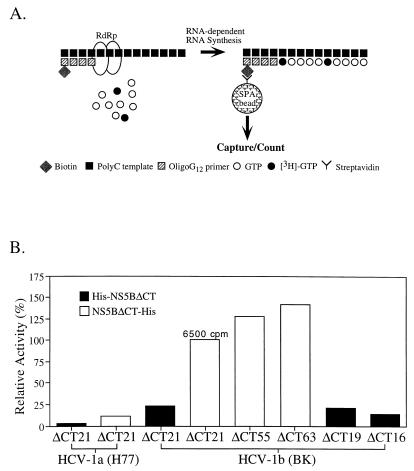FIG. 4.
(A) Illustration of the SPA for RdRp. An SPA (Amersham Life Science) was established for the HCV NS5B RdRp with an RNA homopolymer [poly(C)] as the template complexed with a biotinylated primer [oligo(G)12]. The assay specifically measures the incorporation of tritium-labeled [3H]GMP into the biotinylated RNA products of NS5B which can be captured by the streptavidin-coated SPA beads. The assay conditions were similar to those of a previously described protocol with modifications (4). The assay was carried out at room temperature (≈22°C) for 3 h in a final reaction volume of 50 μl and stopped by adding 50 μl of 100 mM EDTA in phosphate-buffered saline. Unless specified, 50 nM RdRp enzymes were used in the assay containing 250 ng of poly(C)–25 ng of oligo(G)12 and 5 μM or 0.05 μCi of GTP. (B) Comparisons of RdRp activities from different soluble and truncated NS5B proteins. The activity of NS5BΔCT21-His from HCV-1b (BK) is normalized to 100%, which represents a total incorporation of approximately 6,500 cpm. The specific activity is calculated at approximately 870 cpm/pmol of RdRp/h.

